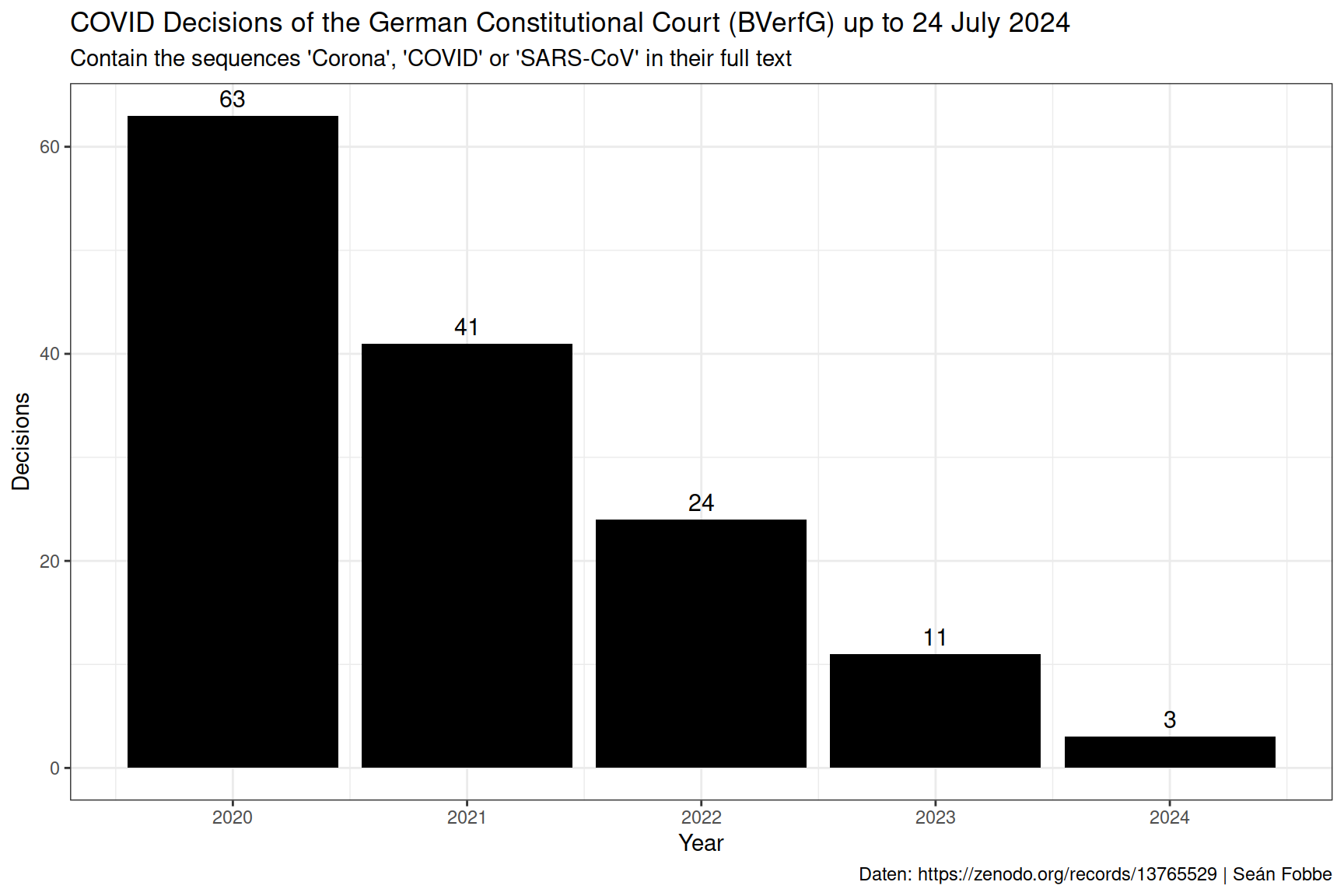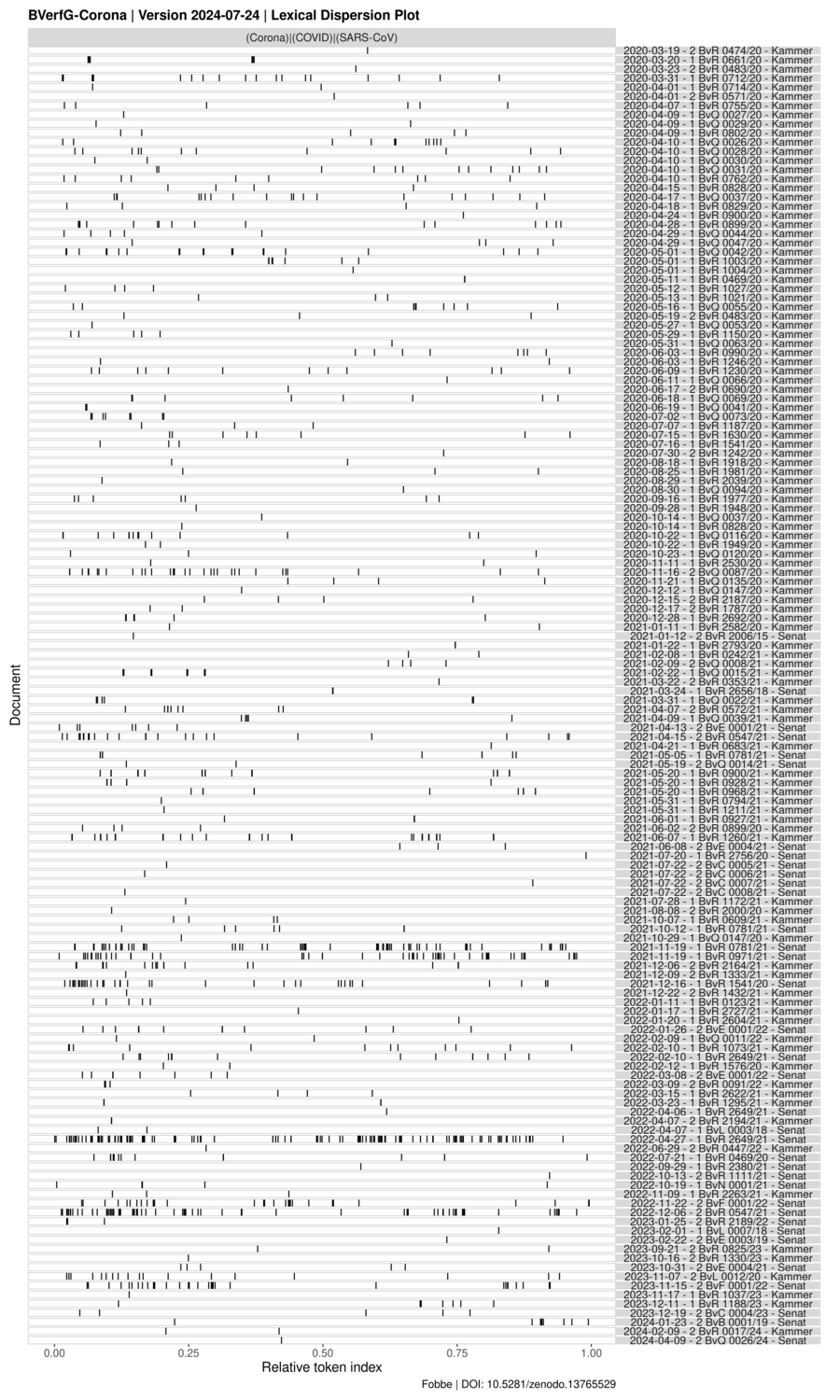- [Open Access] COVID Case Law of the German Constitutional Court (BVerfG-Corona)
- [Open Access] Source Code to the COVID case law dataset
Overview Link to heading
In January 2021 I started publishing a regular compilation of all COVID decisions of the German Constitutional Court, the Bundesverfassungsgericht (BVerfG). Today I published an updated version up to and including 24 July 2024. Now seems like a good time to write a quantitative review of the constitutional court’s COVID case law.
The dataset Corona-Rechtsprechung des Bundesverfassungsgerichts (BVerfG-Corona) is an automated compilation of all BVerfG decisions associated with the novel Corona virus (SARS-CoV-2).
The compilation is based on the Corpus der Entscheidungen des Bundesverfassungsgerichts (CE-BVerfG) and documents all decisions which contain the character sequences “Corona”, “SARS-CoV” or “COVID” in their full text since 1998.
Version 2024-07-24 of the COVID case law dataset contains 142 decisions. The new version contains 13 decisions more than the previous update in February 2023. The data are published in the following formats:
- PDF files for traditional legal research
- TXT files for Legal Data Science
- CSV file containing all keyword hits plus context before and after (KWIC)
- Lexical dispersion plots to provide a quick overview of the case law
Even if you don’t practice Legal Data Science at all, being able to download all COVID decisions as PDF files in a clean ZIP archive is neat, eh?
Time Series: COVID Decisions per Year (2020–2024) Link to heading
Public health measures and restrictions of fundamental rights have been discontinued or scaled back significantly in most countries. The same is true for Germany and this is reflected in the number of COVID-related decisions of the BVerfG, which have notably decreased over time.
For this post I extracted the number of COVID decisions by year from the Compilation Report, created a quick table and visualized the data as a bar plot. The data for 2024 are only partially complete (up to July 2024), but the decreasing trend is readily apparent.
During the pandemic I assumed the BVerfG would keep referring to COVID era norms and events for a long time afterwards, but this does not appear to be the case.
On the one hand this lessening need for constitutional intervention may be due to the lifting of almost all public health restrictions, on the other hand the BVerfG provided many useful constitutional guidelines in its landmark decisions. This may allow the lower courts to do most of the heavy lifting from now on.
Hopefully with more determination than during the pandemic.
1library(data.table)
2library(ggplot2)
3
4dt <- data.table(Year = 2020:2024,
5 Decisions = c(63, 41, 24, 11, 3))
6
7ggplot(data = dt, aes(x = Year, y = Decisions))+
8 geom_bar(stat = "identity", fill = "black")+
9 geom_text(aes(label = Decisions),
10 vjust = -0.5, color = "black", size = 4)+
11 theme_bw()+
12 labs(title = "COVID Decisions of the German Constitutional Court (BVerfG) up to 24 July 2024",
13 subtitle = "Contain the sequences 'Corona', 'COVID' or 'SARS-CoV' in their full text",
14 caption = "Daten: https://zenodo.org/records/13765529 | Seán Fobbe")

Lexical Dispersion Plot Link to heading
Lexical dispersion plots are one of my favorite types of diagram. They are conceptually easy (keyword search), but nevertheless very useful to quickly scan a large corpus for weakly and strongly relevant texts. Weakly relevant texts are those with few hits, strongly relevant texts those with many hits.
Assuming one can find good and (fairly) unique keywords, the search for relevant texts is child’s play. This is especially useful in the legal domain where highly specific language and unique terms abound.
In this case the Corpus der Entscheidungen des Bundesverfassungsgerichts (CE-BVerfG) (contains all published decisions of the BVerfG from 1998 to July 2024) is scanned for the terms “Corona”, “SARS-CoV” or “COVID”. Any of the terms counts as a hit.

I find it fascinating how such a simple technique can reliably show the five landmark COVID decisions of the constitutional court. These are (translated):
- Federal Emergency Brake I: Curfew and Contact Restrictions (19 November 2021)
- Federal Emergency Brake II: School Closures (19 November 2021)
- Triage in the case of disabled patients (16 Dezember 2021)
- Vaccination Certificate (27 April 2022)
- EU COVID lines of credit (6 Dezember 2022)
Summary Link to heading
The COVID case law of the German Constitutional Court, the Bundesverfassungsgericht (BVerfG), is now available up to July 2024 in an easy-to-use digital compilation. The time series shows that the number of COVID decisions has decreased sharply in recent years. It is probable that the BVerfG will declare constitutional closure at some point and the pandemic will move from national and constitutional emergency to simply another episode of legal history.
Let us hope that constitutional law will be more prepared for the next pandemic.